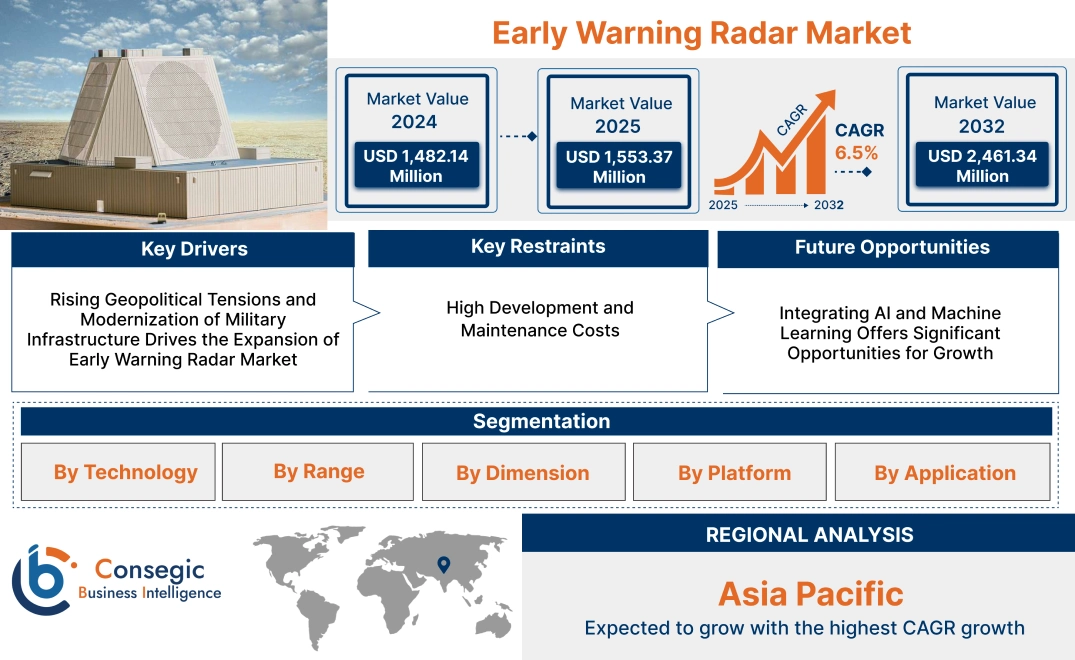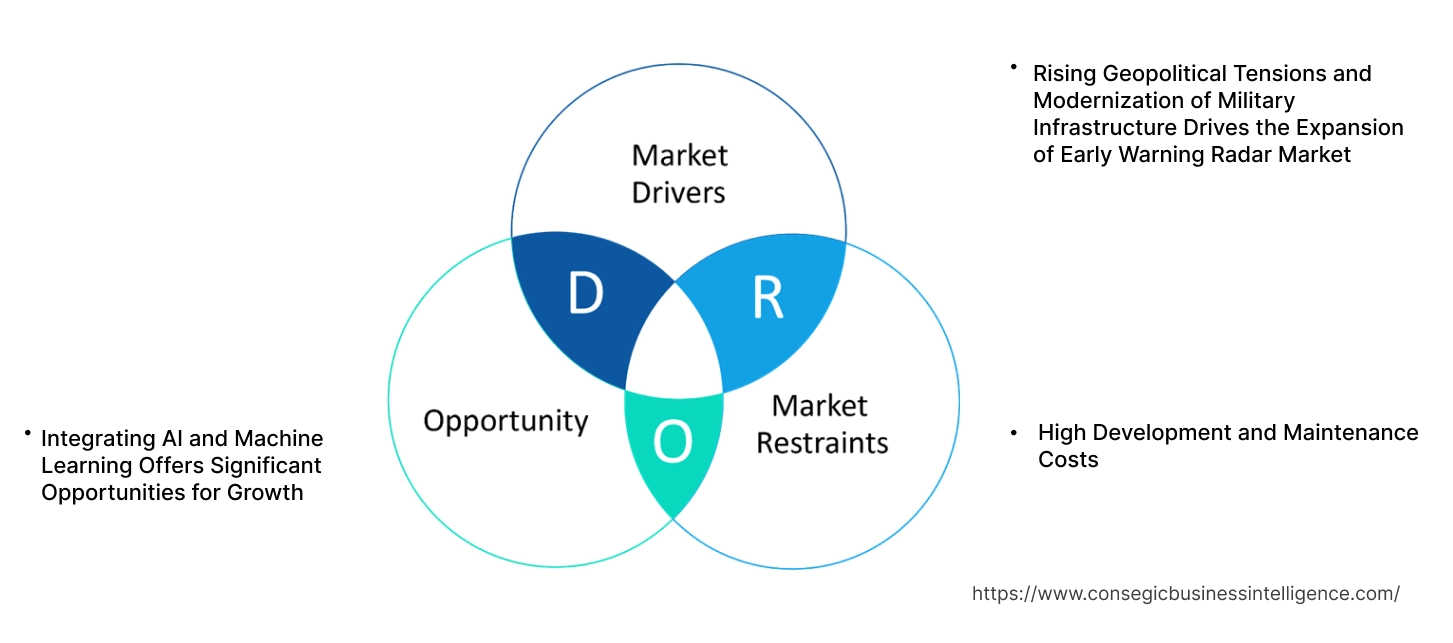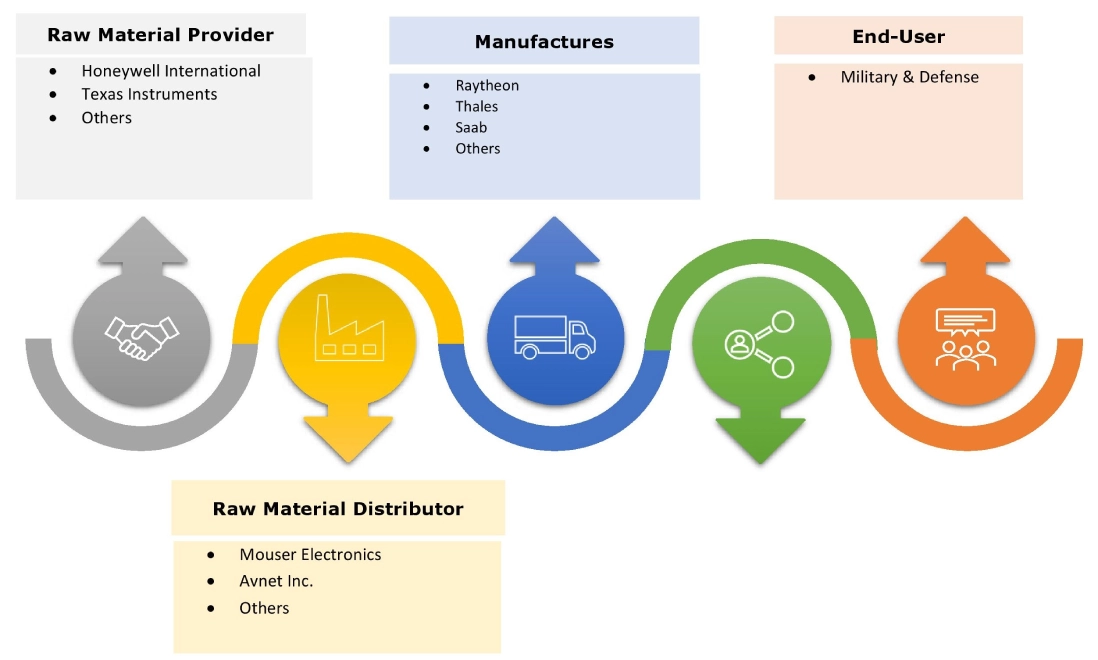- Summary
- Table Of Content
- Methodology
Early Warning Radar Market Size:
Early Warning Radar Market is estimated to reach over USD 2,461.34 Million by 2032 from a value of USD 1,482.14 Million in 2024 and is projected to grow by USD 1,553.37 Million in 2025, growing at a CAGR of 6.5% from 2025 to 2032.
Early Warning Radar Market Scope & Overview:
Early warning radars are specialized radar systems designed to detect and track potential threats at long distances, providing crucial advance notice to enable timely defensive actions. The radars are optimized for detecting and tracking targets, such as aircraft, missiles, and ships, over very long distances. This early detection is vital for providing sufficient time to react to potential threats. Further benefits of early warning radars, including enhanced situational awareness, improved response times, and increased deterrence, are driving market. Also, early warning radars are used for a wide range of applications, including air and missile defense, maritime surveillance, weather surveillance, air traffic control, border security, and others
Key Drivers:
Rising Geopolitical Tensions and Modernization of Military Infrastructure Drives the Expansion of Early Warning Radar Market
Rising geopolitical tensions heighten the perceived threat level, prompting nations to bolster their defense capabilities. This translates to increased defense spending, a significant portion of which is allocated towards modernizing military infrastructure. Further, modernization often involves replacing outdated systems with advanced technologies like early warning radars. These systems offer enhanced detection ranges, improved accuracy, and quicker response times, crucial for maintaining situational awareness and deterring potential adversaries. Further, the ongoing Russia-Ukraine war and Israel-Hamas war serves as a prime example, prompting a surge and expansion in defense spending across the region
- For instance, according to Coordinated Annual Review on Defense (CARD) report, published by European Defence Agency in 2023, European defense expenditure witnessed a 10% year-on-year increase, reaching a record high of USD 301.95 billion. Further, defence spending in European Union is projected to reach USD 352.81 billion in 2024 which in turn is expected to drive the demand for radar systems.
Thus, ongoing conflicts and the threat of potential future confrontations are fueling the demand for market.
Key Restraints:
High Development and Maintenance Costs
The significant upfront investment required for research, development, and procurement of advanced radar technologies poses a substantial barrier to entry for many nations. This includes the cost of sophisticated sensors, complex signal processing algorithms, and seamless integration with existing defense systems. Furthermore, ongoing maintenance costs, encompassing regular inspections, component replacements, software updates, and the skilled personnel necessary for operation and maintenance, contribute significantly to the overall financial burden. These substantial costs can strain defense budgets, forcing nations to make difficult choices regarding resource allocation within their defense priorities, ultimately hindering the widespread adoption of early warning radar technology, particularly for countries with limited financial resources.
Future Opportunities :
Integrating AI and Machine Learning Offers Significant Opportunities for Growth
Integrating AI and machine learning into early warning radar systems offers significant opportunities for growth by revolutionizing their capabilities. AI algorithms can analyze vast amounts of radar data in real-time, enabling faster and more accurate threat detection and classification. Machine learning models can adapt and learn from new threats, enabling the system to anticipate and counter evolving enemy tactics. This enhanced intelligence significantly improves situational awareness, reduces false alarms, and optimizes resource allocation. Furthermore, AI-powered systems can automate many routine tasks, such as target tracking and data analysis, freeing up human operators to focus on more critical decision-making. By leveraging the power of AI and machine learning, early warning radar systems can become more efficient, effective, and adaptable to the ever-changing threat landscape.
Early Warning Radar Market Segmental Analysis :
By Technology:
Based on the technology, the market is segmented into Pulse Doppler Radar, Frequency Modulated Continuous Wave (FMCW) Radar, Synthetic Aperture Radar (SAR), Active Electronically Scanned Array (AESA) Radar, and Others.
Trends in the Technology:
- Increasing adoption of AI and ML algorithms to enhance various aspects of radar performance, including target detection, classification, and tracking.
- Increasing focus on Software-Defined Radar (SDR) allows for greater flexibility and adaptability in radar systems.
Active Electronically Scanned Array (AESA) Radar accounted for the largest revenue share in the year 2024.
- AESA technology is expected to maintain its dominance in the coming years due to its significant advantages over traditional mechanically scanned arrays.
- Further, integration of Gallium Nitride (GaN) technology in AESA systems is a major driver as it offers higher power output, improved efficiency, and better thermal management
- For instance, Northrop Grumman, a key player in Radar market offers Active Electronically Scanned Array (AESA) Radars. These radars are used on fighter jets, bombers, and other aircraft to detect, track, and engage enemy aircraft and missiles.
- Thus, significant advantages over traditional mechanically scanned arrays. and integration of GaN technology is driving the hardware component of market.
Synthetic Aperture Radar (SAR) is anticipated to register the fastest CAGR during the forecast period.
- Ongoing trend of miniaturization of devices which include the development of smaller and more compact SAR systems,
- Further, continuous research is focused on enhancing the spatial and temporal resolution of SAR imagery, providing more detailed and timely information.
- Therefore, miniaturization and focus on enhancing the spatial and temporal resolution of SAR imagery is anticipated to boost the market during the forecast period.
By Range:
Based on the range, the market is segmented into short range, medium range, and long range
Trends in the Range:
- Growing geopolitical tensions and conflicts are a major driver for the rise of long-range and medium-range early warning radar market.
- Continuous advancements in radar technology, such as AESA and GaN, are driving the development of powerful radar systems.
Long Range accounted for the largest revenue share 45.56% in the year 2024.
- Emerging threats of hypersonic missiles and long-range aircraft are leading to the development of long-range radar systems with increased detection capabilities which in turn drives early warning radar market
- Further, benefits including early warning, wide area surveillance, missile defense is driving the development of long range radars
- For instance, Thales offers Ground Master 400 Alpha which can simultaneously detect and track a wide range of airborne threats, from high-altitude fighter-bombers at distances exceeding 515 kilometers to low-flying tactical UAVs concealed within ground clutter. This versatility ensures comprehensive air surveillance and early warning against diverse aerial threats.
- Thus, threats of hypersonic missiles and benefits including early warning, wide area surveillance and others are driving the early warning radar market.
Medium Range is anticipated to register the fastest CAGR during the forecast period.
- Medium-range radars are crucial for enhancing border security and surveillance, enabling the detection and tracking of illegal activities and potential threats.
- Further, these systems play a vital role in maritime surveillance, including coastal defense, search and rescue operations, and maritime traffic monitoring, driving the early warning radar market
- Therefore, enhanced border security & surveillance and increasing adoption of radar system in maritime surveillance is anticipated to boost the market during the forecast period.
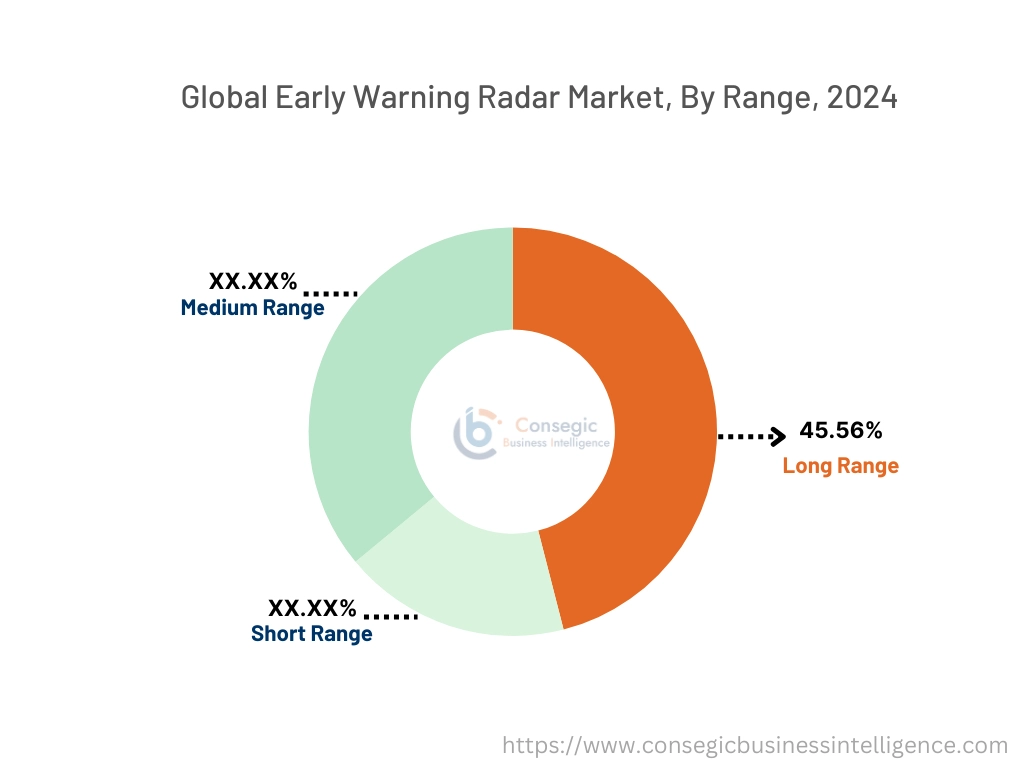
By Dimension:
Based on the dimension, the market is bifurcated into 2D and 3D.
Trends in the Dimension:
- Increasing adoption of radars for maritime surveillance is driving the demand for 2D and 3D radars which in turn fuels the early warning radar market
- 3D radars are crucial for modern air and missile defense systems, enabling the detection and tracking of threats at various altitudes.
2D accounted for the largest revenue share in the year 2024.
- 2D radars are generally more cost-effective to develop, manufacture, and maintain compared to 3D radars which in turn drives the market.
- Further, 2D radars are widely used in air traffic control systems for basic surveillance and tracking of aircraft.
- Furthermore, 2D radars are also used in weather radar systems to track precipitation and other weather phenomena.
- Thus, as per analysis, cost-effectiveness and wide range of uses are driving the demand for 2D radar system
3D is anticipated to register the fastest CAGR during the forecast period.
- Factors including enhanced situational awareness, improved air traffic management, and more precise target engagement in military applications are driving the demand for 3D radar systems.
- Furthermore, advancements in technologies like AESA and digital beamforming are enabling the development of more capable and cost-effective 3D radar systems.
- Therefore, enhanced situational awareness, improved air traffic management, and advancements in technologies are anticipated to boost the growth of the market during the forecast period.
By Platform:
Based on the Platform, the market is bifurcated into airborne radars, land based radars, naval radars, and space based radars
Trends in the Platform:
- Increasing use of radars for border security & surveillance and detecting & tracking illegal activities and potential threats.
- Space-based radars are used for global surveillance and reconnaissance, providing valuable intelligence information.
Land-Based Radars accounted for the largest revenue share in the year 2024.
- Land-based radars are increasingly used due to their widespread deployment for national defense, air & missile defense, and border security.
- Further, integration with other sensors and command-and-control systems is a key trend to improve situational awareness and enhance operational effectiveness.
- Thus, widespread deployment for defense and integration with other sensors and command-and-control systems is driving the market of land-based radars
Space Based Radars is anticipated to register the fastest CAGR during the forecast period.
- Miniaturization of components and advancements in space technology are enabling the development of more capable and cost-effective space-based radar systems.
- Further, space-based radars provide global coverage, enabling surveillance of vast areas that are not easily accessible from ground-based or airborne platforms.
- For instance, in September 2024, Raytheon, an RTX business, has delivered the first sensor payload to Lockheed Martin for the U.S. Space Force's Next-Generation Overhead Persistent Infrared (Next-Gen OPIR) Geosynchronous Earth Orbit (GEO) Block 0 missile warning satellite, keeping the program on schedule for a 2025 launch.
- Therefore, miniaturization of components is anticipated to boost the growth of the market during the forecast period.
By Application:
Based on the application, the market is segmented into air and missile defense, surveillance and reconnaissance, collision avoidance, critical infrastructure protection, and others
Trends in the Application:
- Radar systems can provide early warning of potential threats to critical infrastructure, such as unauthorized intrusions, drone activity, and other suspicious activities.
- Integration of radar systems with cybersecurity measures is a key trend, enabling early detection of cyber threats and enhancing overall security posture.
Air and Missile Defense accounted for the largest revenue share in the year 2024
- Benefits including early warning & detection, target tracking & identification, and situational awareness are driving the market.
- Further, growing threat from hypersonic weapons, drones, and long-range missiles fueling the early warning radar market.
- For instance, Thales offers SMART-L radar system which has a cutting-edge long-range 3D radar utilizing AESA technology. Further, with an exceptional range of 2000 km, it excels in detecting various targets, including stealth aircraft, ballistic missiles, and conventional aircraft. This versatile radar can be deployed on both land and sea platforms, providing crucial surveillance and target designation capabilities.
- Thus, growing threat from hypersonic weapons and benefits including early warning & detection and target tracking are driving the early warning radar market
Critical Infrastructure Protection is anticipated to register the fastest CAGR during the forecast period.
- Critical infrastructure protection as per analysis is experiencing significant growth due to the increasing vulnerability of critical infrastructure to cyberattacks, physical threats, and natural disasters.
- Further, radar systems is used to establish and monitor perimeters around critical infrastructure, enhancing security and deterring unauthorized access.
- Therefore, increasing vulnerability of critical infrastructure is anticipated to boost the growth of the radar industry during the forecast period.
Regional Analysis:
The regions covered are North America, Europe, Asia Pacific, Middle East and Africa, and Latin America.
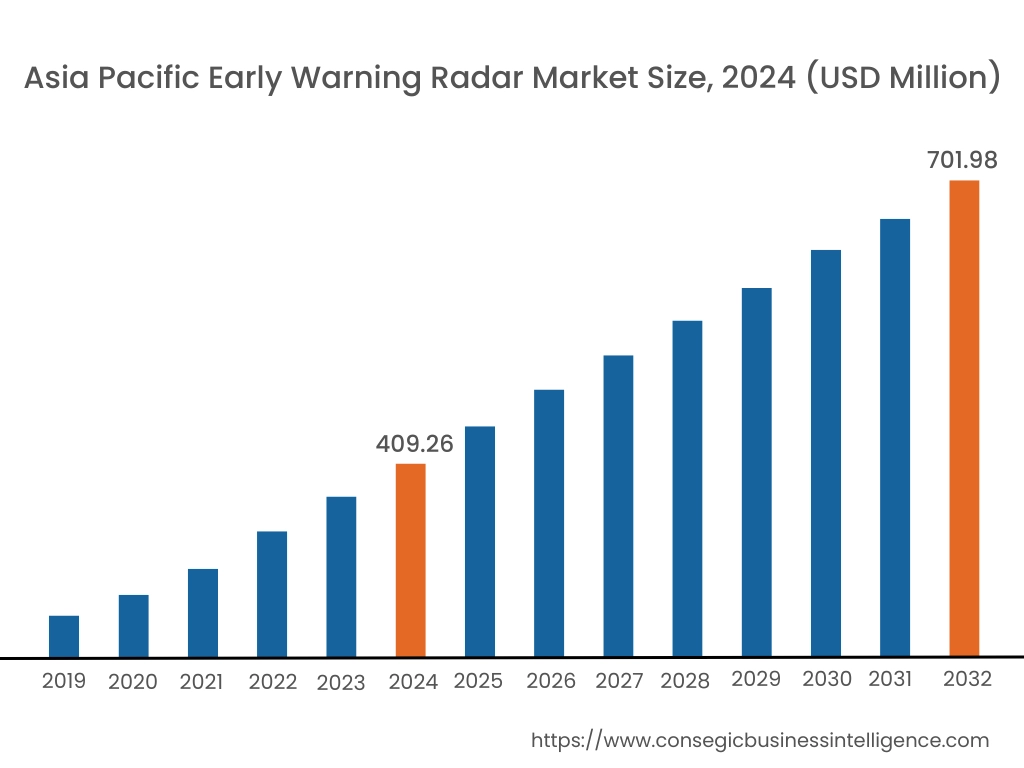
Asia Pacific region was valued at USD 409.26 Million in 2024. Moreover, it is projected to grow by USD 430.10 Million in 2025 and reach over USD 701.98 Million by 2032. Out of this, China accounted for the maximum revenue share of 29.9%. As per research analysis, the early warning radar market is mainly driven by geopolitical tensions and regional conflicts and economic growth and development. Furthermore, government initiatives to modernize defense capabilities and enhance national security are driving significant investments in early warning radar market.
- For instance, January 2024, Japan provided the Philippines with an air surveillance radar system, enhancing the country's ability to monitor the South China Sea amid rising tensions with China. This delivery is part of a larger agreement to provide four radar systems, aimed at strengthening the Philippines' defense capabilities.

North America is estimated to reach over USD 767.94 Million by 2032 from a value of USD 464.17 Million in 2024 and is projected to grow by USD 486.33 Million in 2025. The North American region's growing investment in air and missile defense capabilities and technological advancement offer lucrative prospects for the market. Additionally, presence of key market players such as Raytheon Technologies and Lockheed Martin further drives the radar industry in the region
- For instance, in February 2024, US State Department has approved a possible USD 1.2 billion sale of Airspace and Surface Radar Reconnaissance aerostat systems to Poland. These systems provide aerial surveillance and reconnaissance capabilities. The Defense Security Cooperation Agency has notified Congress of this potential sale.
The regional analysis depicts that geopolitical instability and the rise of new threats, such as terrorism in Europe, is driving the market. Additionally, the primary factors driving the market in the Middle East and African region are regional conflicts and need for enhanced security. Further, as per the analysis, the adoption of early warning radars in internal security, counter-narcotics operations, and disaster management is paving the way for the progress of market trends in Latin America region.
Top Key Players and Market Share Insights:
The global early warning radar market is highly competitive with major players providing solutions to the national and international markets. Key players are adopting several strategies in research and development (R&D), product innovation, and end-user launches to hold a strong position in the early warning radar market. Key players in the early warning radar market include-
- Raytheon (US)
- Thales Group (France)
- Leonardo (Italy)
- L3Harris Technologies (US)
- Hensoldt (Germany)
- Saab (Sweden)
- Lockheed Martin (US)
- BAE Systems (UK)
- Northrop Grumman (US)
- General Dynamics (US)
Recent Industry Developments :
Contracts and Agreements:
- For instance, in February 2023, Saab has secured a contract from the Polish Ministry of Defense for two Saab 340 Airborne Early Warning (AEW) aircraft. These aircraft, equipped with Saab's advanced Erieye radar, will enhance Poland's aerial surveillance capabilities. The contract, valued at approximately SEK 600 million, includes ground equipment and comprehensive support services, and will be fulfilled between 2023 and 2025.
- For instance, in December 2024, ASELSAN and the Turkish Presidency of Defense Industries have signed a USD 170.97 million agreement for the procurement of Air Defense Radar Systems. Deliveries of these systems are scheduled to take place between 2026 and 2031.
Early Warning Radar Market Report Insights :
| Report Attributes | Report Details |
| Study Timeline | 2019-2032 |
| Market Size in 2032 | USD 2,461.34 Million |
| CAGR (2025-2032) | 6.5% |
| By Technology |
|
| By Range |
|
| By Dimension |
|
| By Platform |
|
| By Application |
|
| By Region |
|
| Key Players |
|
| North America | U.S. Canada Mexico |
| Europe | U.K. Germany France Spain Italy Russia Benelux Rest of Europe |
| APAC | China South Korea Japan India Australia ASEAN Rest of Asia-Pacific |
| Middle East and Africa | GCC Turkey South Africa Rest of MEA |
| LATAM | Brazil Argentina Chile Rest of LATAM |
| Report Coverage |
|
Key Questions Answered in the Report
How big is the Early Warning Radar Market? +
The Early Warning Radar Market is estimated to reach over USD 2,461.34 Million by 2032 from a value of USD 1,482.14 Million in 2024 and is projected to grow by USD 1,553.37 Million in 2025, growing at a CAGR of 6.5% from 2025 to 2032.
What specific segmentation details are covered in the Early Warning Radar report? +
The Early Warning Radar report includes specific segmentation details for technology, range, dimension, platform, application, and regions.
Which is the fastest segment anticipated to impact the market growth? +
In the Early Warning Radar Market, the 3D radar is the fastest-growing segment during the forecast period due to its ability to provide more accurate and comprehensive information about airborne threats, including their location, altitude, and velocity.
Who are the major players in the Early Warning Radar Market? +
The key participants in the Early Warning Radar Market are Raytheon (US), Thales Group (France), Saab (Sweden), Lockheed Martin (US), BAE Systems (UK), Northrop Grumman (US), General Dynamics (US), Leonardo (Italy), L3Harris Technologies (US), Hensoldt (Germany), and others.
What are the key trends in the Early Warning Radar Market? +
The Early Warning Radar Market is being shaped by several key trends including increasing geopolitical tensions, advancements in radar technology, growing demand for integrated air and missile defense systems, and the rising adoption of unmanned aerial vehicles (UAVs).
